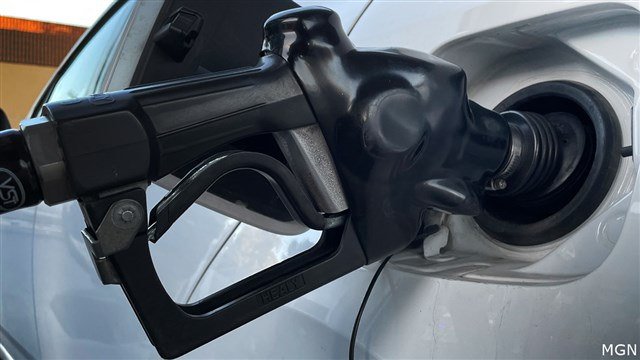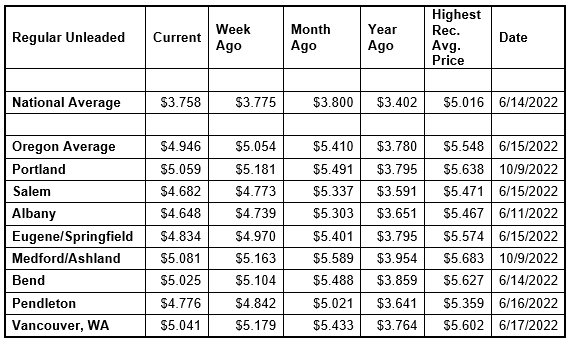Oregon average gas price falls 11 cents in past week, to $4.95 a gallon, AAA reports; third-largest drop in U.S.

(Update: AAA weekly report)
PORTLAND, Ore. (KTVZ) – Gas prices continue to fall, as expected this time of year, with Oregon and other West Coast states again seeing the largest declines in the nation, AAA Oregon-Idaho reported Tuesday.
Tepid demand for gas and crude oil prices below $90 per barrel are the main drivers. For the week, the national average for regular slips two cents to $3.76 a gallon. The Oregon average loses 11 cents to $4.95. This is the third-largest weekly drop for a state in the nation, only behind Alaska (-21 cents) and California (-17 cents).

“Gas prices have been falling for the last three weeks. Here on the West Coast, pump prices shot up in late September after several regional refineries underwent planned and unplanned maintenance, putting a significant crimp in supplies,” says Marie Dodds, public affairs director for AAA Oregon/Idaho. “Barring unforeseen events, lackluster demand for gas in the U.S. along with relatively low crude oil prices should continue to put downward pressure on pump prices.”
The Oregon average came within a penny of reaching a new record high last month when it got to $5.54 a gallon on October 9. The national average climbed to $3.92 on October 11. Both the national and Oregon averages hit record highs in mid-June, then declined for 14 consecutive weeks before rising again starting in late September. The national average reached its record high of $5.016 on June 14 while the Oregon average reached its record high of $5.548 on June 15.
Crude oil prices have stayed below $90 per barrel since October 10. Crude reached a recent high of $122.11 per barrel on June 8, and ranged from about $94 to $110 per barrel in July. In August, crude prices ranged between about $86 and $97. In September, crude prices ranged between about $76 and $88 per barrel. In October, crude ranged between $82 and $92 per barrel.
Crude prices rose dramatically leading up to and in the first few months of Russia’s invasion of Ukraine. Russia is one of the world’s top oil producers and its involvement in a war causes market volatility, and sanctions imposed on Russia by the U.S. and other western nations resulted in tighter global oil supplies. Oil supplies were already tight around the world as demand for oil increased as pandemic restrictions eased. A year ago, crude was around $72 per barrel compared to $88 today.
Crude oil is the main ingredient in gasoline and diesel, so pump prices are impacted by crude prices on the global markets. On average, about 53% of what we pay for in a gallon of gasoline is for the price of crude oil, 12% is refining, 21% distribution and marketing, and 15% are taxes, according to the U.S. Energy Information Administration.
Demand for gasoline in the U.S. increased slightly from 8.68 million b/d to 8.93 million b/d for the week ending October 21. This is nearly 400,000 bbl lower than this time last year. Total domestic gasoline stocks decreased from 209.4 million bbl to 207.9 million bbl. If demand remains low and oil prices don’t spike, pump prices will likely keep falling.
Quick stats
Oregon is one of 34 states and the District of Columbia with lower prices week-over-week. West Coast states have the largest weekly drops: Alaska (-21 cents), California (-17 cents), Oregon (-11), and Washington (-9 cents). Rhode Island (+27 cents) has the largest weekly gain.
California ($5.54) has the most expensive gas in the country for the eighth week in a row. California and Hawaii ($5.21) are the only two states with averages at or above $5 a gallon. This week 11 states, including Oregon, have averages at or above $4, and 39 states and the District of Columbia have averages in the $3-range.
The cheapest gas in the nation is in Georgia ($3.15) and Texas ($3.17). For the 95th week in a row, no state has an average below $2 a gallon.
The difference between the most expensive and least expensive states is $2.39 which is significant.
Oregon is one of 27 states and the District of Columbia with lower prices now than a month ago. The national average is four cents less and the Oregon average is 46 cents less than a month ago. Oregon has the third-largest monthly decrease in the nation. California (-82 cents) and Nevada (-51 cents) have the largest monthly declines. Rhode Island (+46 cents) has the largest month-over-month jump.
Oregon is one of 48 states and the District of Columbia with higher prices now than a year ago. The national average is 36 cents more and the Oregon average is $1.17 more than a year ago. This is the largest year-over-year increase in the nation, followed by Alaska (+$1.12), Washington (+$1.03), Nevada (+$1.03), California (+94 cents), Hawaii (+90 cents) and Arizona (+77 cents)—all of the states in the West Coast region. Colorado (+2 cents) has the smallest year-over-year increase. Georgia (-10 cents) and Florida (-2 cents) are the only two states with year-over-year declines.
West Coast
The West Coast region continues to have the most expensive pump prices in the nation with all seven states in the top 10. This is typical for the West Coast as this region tends to consistently have fairly tight supplies, consuming about as much gasoline as is produced. In addition, this region is located relatively far from parts of the country where oil drilling, production and refining occurs, so transportation costs are higher. And environmental programs in this region add to the cost of production, storage and distribution.
Refinery issues in California in September and October exacerbated the situation, creating extremely tight supplies and causing pump prices in this region to skyrocket.
| Rank | Region | Price on 11/1/22 | ||
| 1 | California | $5.54 | ||
| 2 | Hawaii | $5.21 | ||
| 3 | Nevada | $4.97 | ||
| 4 | Oregon | $4.95 | ||
| 5 | Washington | $4.91 | ||
| 6 | Alaska | $4.84 | ||
| 7 | Idaho | $4.33 | ||
| 8 | Arizona | $4.29 | ||
| 9 | Illinois | $4.16 | ||
| 10 | Utah | $4.14 |
As mentioned above, California is the most expensive state for the eighth consecutive week with Hawaii, Nevada, Oregon, Washington, and Alaska rounding out the top six. Arizona is eighth. Oregon slips to fourth after five weeks at third.
Four of the seven states in the region are seeing the largest weekly declines in the country: Alaska (-21 cents), California (-17 cents), Oregon (-11), and Washington (-9 cents). Nevada (-7 cents) and Arizona (-6 cents) also have week-over-week declines. Hawaii (+1/2 cent) is the only state in the region with a weekly gain.
The refinery utilization rate on the West Coast fell from 82.3% to 81.1% for the week ending October 21. The rate has ranged between about 76% and 90% in the last year.
According to EIA’s latest weekly report, total gas stocks in the region rose from 25.89 million bbl. to 26.16 million bbl.
Oil market dynamics
A lower dollar contributed to price increases earlier last week; however, market concerns about global crude demand, after China announced more COVID lockdowns, sent prices lower at the end of the week. For this week, persistent market concerns that economic growth will stall or decline, alongside decreased crude oil demand, could put downward pressure on prices.
At the close of Friday’s formal trading session, WTI decreased by $1.18 to settle at $87.90. At the close of Monday’s formal trading session, WTI lost $1.37 cents to close at $86.53. Today crude is trading around $88, compared to $85 a week ago. Crude prices are about $3 more than a year ago.
Drivers can find current gas prices along their route with the free AAA Mobile app for iPhone, iPad and Android. The app can also be used to map a route, find discounts, book a hotel and access AAA roadside assistance. Learn more at AAA.com/mobile.
--
Earlier story:
CHICAGO (KTVZ) -- Average gasoline prices in Oregon have fallen 14.9 cents per gallon in the last week, averaging $4.90/gallon Monday, according to GasBuddy's survey of 1,307 stations in Oregon.
Prices in Oregon are 42.0 cents per gallon lower than a month ago and stand $1.18/g higher than a year ago. The national average price of diesel has declined 2.39 cents in the last week and stands at $5.28 per gallon.
According to GasBuddy price reports, the cheapest station in Oregon was priced at $3.89/g Sunday while the most expensive was $5.79/g, a difference of $1.90/g. The lowest price in the state Sunday was $3.89/g while the highest was $5.79/g, a difference of $1.90/g.
The national average price of gasoline has fallen 4.7 cents per gallon in the last week, averaging $3.72/g Monday. The national average is down 3.0 cents per gallon from a month ago and stands 34.4 cents per gallon higher than a year ago, according to GasBuddy data compiled from more than 11 million weekly price reports covering over 150,000 gas stations across the country.
Historical gasoline prices in Oregon and the national average going back ten years:
October 31, 2021: $3.72/g (U.S. Average: $3.38/g)
October 31, 2020: $2.46/g (U.S. Average: $2.11/g)
October 31, 2019: $3.33/g (U.S. Average: $2.61/g)
October 31, 2018: $3.31/g (U.S. Average: $2.77/g)
October 31, 2017: $2.71/g (U.S. Average: $2.48/g)
October 31, 2016: $2.54/g (U.S. Average: $2.20/g)
October 31, 2015: $2.29/g (U.S. Average: $2.17/g)
October 31, 2014: $3.15/g (U.S. Average: $2.99/g)
October 31, 2013: $3.40/g (U.S. Average: $3.27/g)
October 31, 2012: $3.81/g (U.S. Average: $3.51/g)
Some urban areas and their current gas prices:
Eugene- $4.83/g, down 15.8 cents per gallon from last week's $4.99/g.
Salem- $4.61/g, down 15.3 cents per gallon from last week's $4.76/g.
Portland- $5.06/g, down 14.8 cents per gallon from last week's $5.20/g.
"For the third consecutive week, we've seen the national average price of gasoline decline, and while it's good news for most regions with a continued drop in prices, the Northeast is bucking the trend and seeing a noticeable jump due to tight supply," said Patrick De Haan, head of petroleum analysis at GasBuddy.
"The national average is closing in on the previous low from September, which was interrupted when refinery issues caused prices to skyrocket in the West and Great Lakes. With those issues addressed, the West has seen prices plummet, including a nearly 90 cent per gallon decline in California in less than a month. Compare that to the Northeast, where prices have jumped some 10-25 cents per gallon, demonstrating there's much regionality to current gasoline price trends. Add in diesel prices that remain high amidst extremely tight supply, and there's definitely some challenges that lie ahead."
GasBuddy is the authoritative voice for gas prices and the only source for station-level data. GasBuddy's survey updates 288 times every day from the most diverse list of sources covering nearly 150,000 stations nationwide, the most comprehensive and up-to-date in the country. GasBuddy data is accessible at http://prices.GasBuddy.com.
GasBuddy also fuels KTVZ.COM's Pump Patrol, a report on the lowest gas prices on the High Desert.